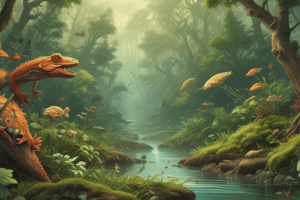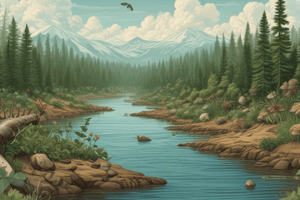Podcast
Questions and Answers
Which of the following is NOT a criterion for an invasive species?
Which of the following is NOT a criterion for an invasive species?
- Being native to the area (correct)
- Exotic origin
- Causing significant economic or ecological damage
- Rapid population growth
The majority of exotic species become invasive.
The majority of exotic species become invasive.
False (B)
What is the main reason behind the rapid spread of the spongy moth in North America?
What is the main reason behind the rapid spread of the spongy moth in North America?
The spongy moth was introduced by Etenne Leopold Trouvelot and has spread rapidly since its introduction.
The use of natural enemies to control pests or weeds is called ______.
The use of natural enemies to control pests or weeds is called ______.
Which of the following are common examples of human activities that can facilitate the spread of invasive species? (Select all that apply)
Which of the following are common examples of human activities that can facilitate the spread of invasive species? (Select all that apply)
Match the following terms related to invasion biology with their descriptions:
Match the following terms related to invasion biology with their descriptions:
Which of the following are examples of natural mechanisms of ERD?
Which of the following are examples of natural mechanisms of ERD?
Human-mediated ERD is characterized by introducing species at a faster rate than natural processes.
Human-mediated ERD is characterized by introducing species at a faster rate than natural processes.
What are the two main processes that determine species richness on islands, according to the theory of island biogeography?
What are the two main processes that determine species richness on islands, according to the theory of island biogeography?
The theory of island biogeography was proposed by _ and _.
The theory of island biogeography was proposed by _ and _.
Match the following transport vectors with their categories:
Match the following transport vectors with their categories:
Which of the following is an example of an intentionally introduced plant that has become a major weed?
Which of the following is an example of an intentionally introduced plant that has become a major weed?
Human-mediated ERD is always intentional.
Human-mediated ERD is always intentional.
What is one reason why human-mediated ERD is more likely to yield multiple introductions compared to natural ERD?
What is one reason why human-mediated ERD is more likely to yield multiple introductions compared to natural ERD?
The majority of non-native plants established in the USA were intentionally introduced for ornamental purposes.
The majority of non-native plants established in the USA were intentionally introduced for ornamental purposes.
Which of the following is NOT a common unintentional vector for non-native species?
Which of the following is NOT a common unintentional vector for non-native species?
The _____ vector is a significant concern due to the large number of live animals imported, with a significant portion of shipments labeled vaguely.
The _____ vector is a significant concern due to the large number of live animals imported, with a significant portion of shipments labeled vaguely.
What is the conundrum associated with arboreta and zoos in relation to invasive species?
What is the conundrum associated with arboreta and zoos in relation to invasive species?
Match the following intentional vectors of non-native species with their descriptions.
Match the following intentional vectors of non-native species with their descriptions.
Which of the following is an example of an intentional vector of non-native species used in the early days of biological control?
Which of the following is an example of an intentional vector of non-native species used in the early days of biological control?
Name two factors that determine the strength of a transport pathway for non-native species.
Name two factors that determine the strength of a transport pathway for non-native species.
Nurseries play a crucial role in the spread of non-native insect herbivores and fungi.
Nurseries play a crucial role in the spread of non-native insect herbivores and fungi.
Which of the following is NOT a critical assumption of the approach described in the text?
Which of the following is NOT a critical assumption of the approach described in the text?
The concept of "invasibility" suggests that all habitats are equally susceptible to invasion by exotic species.
The concept of "invasibility" suggests that all habitats are equally susceptible to invasion by exotic species.
What is the primary factor that explains the higher number of invasive species on islands compared to mainland areas?
What is the primary factor that explains the higher number of invasive species on islands compared to mainland areas?
The equation E = I x S represents the relationship between the number of exotic species (E), the number of exotic species introduced (I), and the ______ rate or rate of establishment (S).
The equation E = I x S represents the relationship between the number of exotic species (E), the number of exotic species introduced (I), and the ______ rate or rate of establishment (S).
Match the following terms with their corresponding descriptions:
Match the following terms with their corresponding descriptions:
The California region has a significantly lower percentage of exotic species compared to the Mediterranean Basin, despite having similar climates.
The California region has a significantly lower percentage of exotic species compared to the Mediterranean Basin, despite having similar climates.
Which of the following scenarios would likely contribute to a high number of exotic species in a region?
Which of the following scenarios would likely contribute to a high number of exotic species in a region?
What is the primary reason why direct comparisons of "invasibility" between regions might be inaccurate?
What is the primary reason why direct comparisons of "invasibility" between regions might be inaccurate?
Which of the following statements about the spread of invasive species through air travel is TRUE, according to the information provided?
Which of the following statements about the spread of invasive species through air travel is TRUE, according to the information provided?
The 'tens rule' suggests that the probability of an invasive species successfully becoming established as a pest is consistently 1 in 10, regardless of the species and geographic location.
The 'tens rule' suggests that the probability of an invasive species successfully becoming established as a pest is consistently 1 in 10, regardless of the species and geographic location.
What is the key question raised regarding the rate of invasive species introduction after a transportation pathway is established?
What is the key question raised regarding the rate of invasive species introduction after a transportation pathway is established?
The __________ is a classic trend observed for invasive species, suggesting a decreasing probability of success at each stage of range expansion.
The __________ is a classic trend observed for invasive species, suggesting a decreasing probability of success at each stage of range expansion.
Match the following invasive species with their origin:
Match the following invasive species with their origin:
The 'hub & spoke' model of air travel is beneficial for preventing the spread of invasive species due to its increased efficiency.
The 'hub & spoke' model of air travel is beneficial for preventing the spread of invasive species due to its increased efficiency.
What is a significant consequence of repeated sampling of species from the same donor regions using ships?
What is a significant consequence of repeated sampling of species from the same donor regions using ships?
Which of these factors influences the success of the 'tens rule' in predicting the spread of invasive species?
Which of these factors influences the success of the 'tens rule' in predicting the spread of invasive species?
Flashcards
Invasive Species
Invasive Species
Species that are exotic and cause significant economic or ecological damage.
Exotic Species
Exotic Species
Species introduced to an area where they are not native.
Human Facilitation
Human Facilitation
Human activities that assist the spread of invasive species.
Biological Control
Biological Control
Signup and view all the flashcards
Accidental Releases
Accidental Releases
Signup and view all the flashcards
Vectors
Vectors
Signup and view all the flashcards
Pathways
Pathways
Signup and view all the flashcards
Extra-range Dispersal
Extra-range Dispersal
Signup and view all the flashcards
Natural Mechanisms of ERD
Natural Mechanisms of ERD
Signup and view all the flashcards
Human-Mediated EDR
Human-Mediated EDR
Signup and view all the flashcards
Ecological Disruption
Ecological Disruption
Signup and view all the flashcards
Theory of Island Biogeography
Theory of Island Biogeography
Signup and view all the flashcards
Immigration (in Biogeography)
Immigration (in Biogeography)
Signup and view all the flashcards
Extinction (in Biogeography)
Extinction (in Biogeography)
Signup and view all the flashcards
Intentional Transport Vectors
Intentional Transport Vectors
Signup and view all the flashcards
Unintentional Transport Vectors
Unintentional Transport Vectors
Signup and view all the flashcards
Air Trade Impact
Air Trade Impact
Signup and view all the flashcards
Hub & Spoke Model
Hub & Spoke Model
Signup and view all the flashcards
Nutria Invasion
Nutria Invasion
Signup and view all the flashcards
Tens Rule
Tens Rule
Signup and view all the flashcards
Invasion Probability Variance
Invasion Probability Variance
Signup and view all the flashcards
Biodiversity Accumulation Curves
Biodiversity Accumulation Curves
Signup and view all the flashcards
Historical Transport Vectors
Historical Transport Vectors
Signup and view all the flashcards
Pearl Harbor Dredging
Pearl Harbor Dredging
Signup and view all the flashcards
Species Discovery Rate
Species Discovery Rate
Signup and view all the flashcards
Invasion Debt
Invasion Debt
Signup and view all the flashcards
Invasibility
Invasibility
Signup and view all the flashcards
Transport Model
Transport Model
Signup and view all the flashcards
Geographic Trends
Geographic Trends
Signup and view all the flashcards
Control for I
Control for I
Signup and view all the flashcards
Surrogate for Trade
Surrogate for Trade
Signup and view all the flashcards
Lag in Species Introduction
Lag in Species Introduction
Signup and view all the flashcards
Intention Vectors
Intention Vectors
Signup and view all the flashcards
Biofuel Crops
Biofuel Crops
Signup and view all the flashcards
Live Wildlife Trade
Live Wildlife Trade
Signup and view all the flashcards
Biocontrol Vector
Biocontrol Vector
Signup and view all the flashcards
Arboreta & Zoos
Arboreta & Zoos
Signup and view all the flashcards
Hitchhiking Species
Hitchhiking Species
Signup and view all the flashcards
Nursery Vector
Nursery Vector
Signup and view all the flashcards
Transport Pathway Strength
Transport Pathway Strength
Signup and view all the flashcards
Study Notes
Invasive Species Introduction Criteria
- Invasive species must be exotic (not native)
- They must cause significant economic or ecological damage
- Only about 10% of exotic species are invasive
Factors Causing Invasion
- Many factors, often unique to each case
- Common factors include:
- Human facilitation
- Lack of natural enemies
- Interactions with other invasive species
Intentional Introduction of Exotics
- Deliberately introducing species to a new habitat
- Negative consequences may not be anticipated at the time of release
Biological Control
- Introducing the natural enemy of a pest to control it.
- This can sometimes backfire if the introduced species becomes a pest itself
Accidental Releases
- Inadequate screening of imports
- Stowaways during transport of goods
- Gross negligence (e.g., bait bucket introductions)
Indirect Influences on Exotic Species Expansion
- Human activity can facilitate expansion via these factors:
- Climate change
- Natural enemy reductions (e.g., overfishing)
- Habitat modification
Importance of Ecological Theory
- General ecological mechanisms impact biological invasions in a testable way.
- Examination of these mechanisms can predict invasion processes.
- Predictive ability supports proactive strategies for managing invasions
Importance of Case Studies
- Case studies provide empirical data for testing theoretical principles.
- Exceptions to established rules can lead to paradigm shifts in understanding invasions
Corridors of Invasion: The Spongy Moth
- Lymantria dispar (spongy moth) introduced by Etenne Leopold Trouvelot
- Rapid spread since introduction, causing significant deforestation (> 80 million acres by 1970)
Invasion Stages
- Transport
- Introduction
- Establishment
- Spread
- Impact (low to high, based on human perception of impact)
Two Key Concepts: Vectors and Pathways
- Vectors: The mechanisms for transporting organisms from their native habitat to a new habitat (e.g., wind, water, animals)
- Pathways: The routes between the source and novel habitat
Extra-Range Dispersal (ERD)
- Movements beyond a species' current range, including natural (wind, animals) and human-mediated dispersal
- Human-mediated ERD deposits species at a faster rate than natural dispersal mechanisms
Theory of Island Biogeography
- Species richness in isolated habitats results from two processes:
- Immigration
- Extinction
Natural Immigration Rate in Hawai'i
- Hawai'i's indigenous flora arrived at a rate of about one new colonization every 100,000 years.
Types of Transportation Vectors
- Intentional Vectors (e.g. food, biocontrol, pet trade): species deliberately introduced for a defined purpose
- Unintentional Vectors: species moved unintentionally as a byproduct, such as by hitching a ride in transported materials or cargo holds
Transport Vectors: The Role of Food
- Many exotic plant and animal species used for food were intentionally introduced.
- Some have escaped cultivation and established in natural areas
- Examples include St. John's Wort and Kudzu
Intentional Vectors: Non-food
- Biofuel crops are examples of species purposefully introduced (for ease of production or higher yields).
Ship Ballast and Nursery Plants as Vectors
- Ship ballast (water or solids) can transport plants and insects.
- Nurseries can unintentionally propagate exotic pests and species.
Strength of Transport Pathway Determinants
- Numbers of transported species
- Conditions of transported organisms at arrival
The "Tens Rule"
- Probability of an introduced species progressing to the next stage of invasion and establishment is approximately 1 in 10
Invasive Species Trends
- Species introduction rates tend to increase over time in a given area
- The total number of exotic species present in a particular location generally increases over time
Invasion Delays
- Changes in vector strength don't always immediately result in an increase in introduced species
- Delays exist in relationship between factors like GDP and established exotic species.
Species Accumulation Curves
- Ecologists use plots to study biodiversity
- Newly sampled plots find new species and existing ones
- Rate of discovery of new species declines as more places are sampled
Major Geographic Trends
- Higher number of invasive species in islands compared to mainland areas
- Reversal of latitudinal trends from baseline between old and new world areas
Critical Assumptions of Approach
- Trade volume must not increase in a way that increases deposited species
- There should be no change in the types of goods transported
- Inspections and regulation must remain consistent
Studying That Suits You
Use AI to generate personalized quizzes and flashcards to suit your learning preferences.




